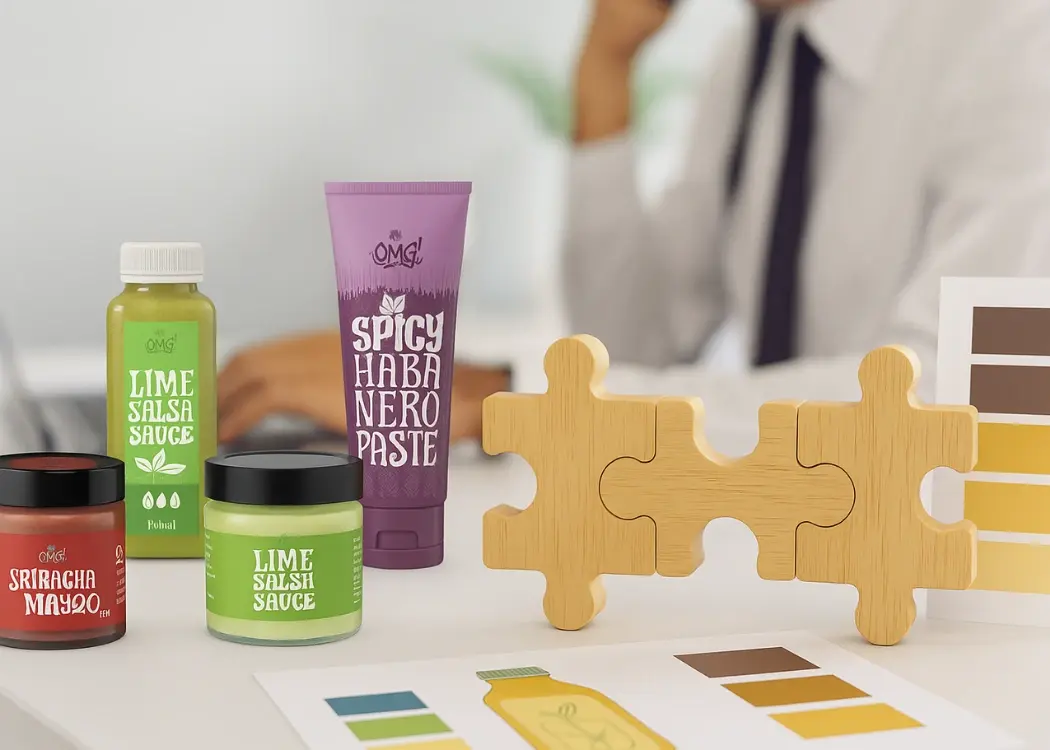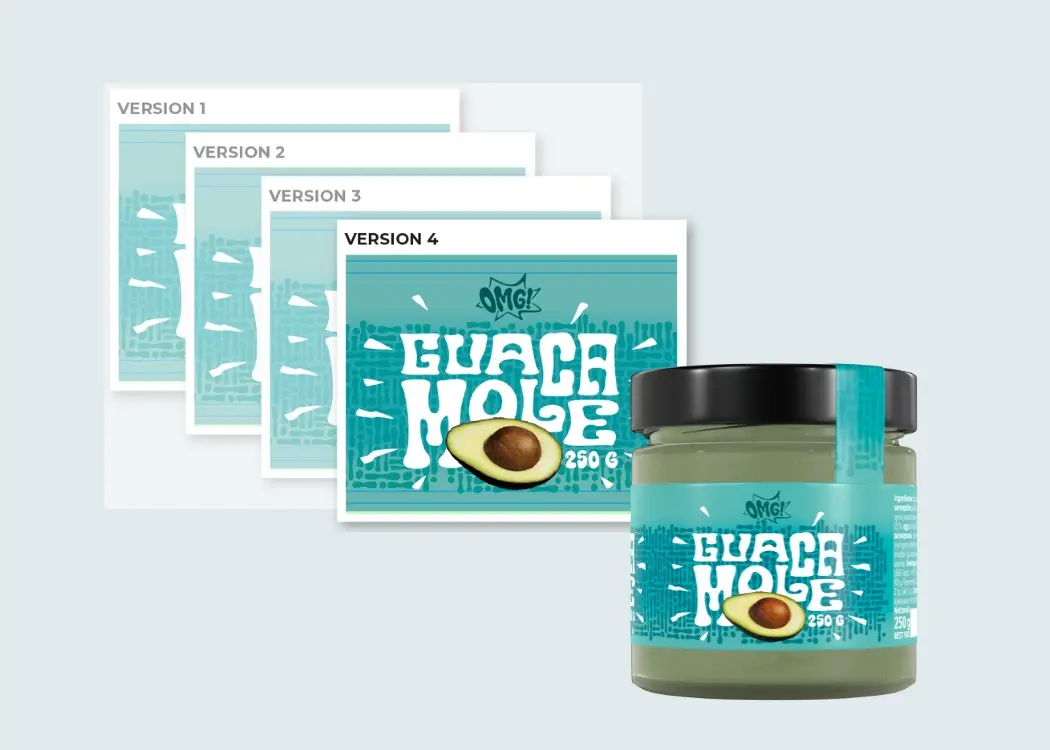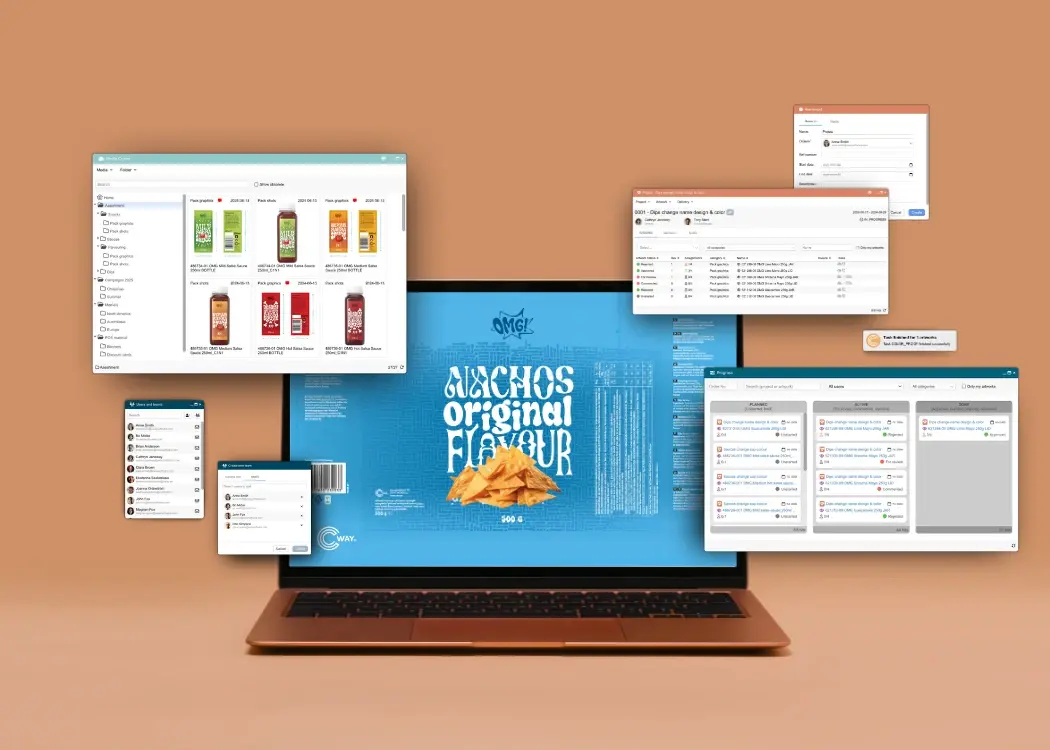Streamline your creative approval process for faster sign-off
If you're part of a marketing team, you're probably no stranger to the back-and-forth that comes with getting creative content approved. Whether it’s...
5 min read
 Ekaterina Skalatskaia
:
June 5, 2025 at 4:00 PM
Ekaterina Skalatskaia
:
June 5, 2025 at 4:00 PM

In the race to capture consumer attention, packaging can make or break a product. Yet, managing packaging design isn't as straightforward as briefing a designer and approving a pretty label.
The real problem? Many companies manage packaging design chaotically — scattered files, endless email chains, delayed approvals, and ultimately, inconsistent packaging that weakens the brand.
Why does this happen? Because packaging design operates on three different levels — strategic, tactical, and operational — and when these levels aren't aligned, confusion takes over.
Let’s break it down — and more importantly, let's solve it.
When people think about packaging, they often picture colors, logos, or materials. But there’s a lot more happening behind the scenes — especially at the strategic level. Here, packaging becomes a powerful tool for translating the company's brand vision and business goals into a tangible, consumer-facing reality.
Think of this level as the architect’s blueprint for your entire packaging ecosystem. Without a clear strategy, every new product risks becoming a rogue element, diluting brand identity and confusing customers.
In fact, according to Wikipedia, design management plays a vital role in aligning a company's design activities — like packaging — with its corporate or brand strategy. A carefully managed design strategy ensures consistency across markets and strengthens brand equity.
Define brand identity guidelines for packaging — including consistent use of colors, typography, materials, and visual elements that communicate the brand's core values.
Set long-term goals that shape future packaging initiatives, such as sustainability targets (reducing plastic use or adopting recyclable materials) or innovation roadmaps (introducing smart packaging or new materials).
Ensure packaging design reflects the brand promise and resonates with the target market — whether it's a luxury feel for premium cosmetics or eco-friendly cues for organic food brands.
Stay ahead of market trends and regulatory changes, adapting packaging strategies to evolving consumer preferences and compliance requirements.
When executed well, strategic packaging design doesn’t just make a product look attractive — it builds brand recognition, drives consumer loyalty, and supports market positioning. Without it, companies risk creating inconsistent packaging that erodes trust and weakens their market presence.
Our experts bring over 20 years of experience working with leading European brands. Get a free consultation to identify bottlenecks and optimize your design workflows.
Once the brand strategy is clear, it’s time to move from vision to action. That’s where tactical packaging design management comes into play. Here, the focus shifts to how packaging projects are executed — setting up the teams, processes, and workflows that turn big ideas into real, tangible outputs.
If the strategic level is the blueprint, the tactical level is the construction crew coordinating every moving part.
At this stage, it’s crucial to balance creative freedom with operational discipline. Without clear organization, even the best strategy can unravel into missed deadlines and fragmented designs. According to Wikipedia’s overview of design management, this level is about managing quality and consistency across different design disciplines, ensuring that execution matches the original vision.
Assemble cross-functional teams — designers, legal, regulatory, marketing, and procurement — to ensure all perspectives are aligned from the start.
Create efficient workflows for briefs, approvals, revisions, and sign-offs, ensuring that no step is skipped and nothing falls through the cracks.
Standardize processes and templates to save time and avoid reinventing the wheel with every new project.
Manage timelines and resources, making sure that packaging projects hit critical milestones without burning out teams or blowing budgets.
When this level runs smoothly, companies enjoy faster time-to-market and fewer costly mistakes. But when it’s neglected, chaos ensues — endless email chains, lost feedback, and that all-too-familiar panic when a launch date looms and the packaging still isn’t final.
Cway makes tactical design management effortless by offering pre-built workflow templates, automated task assignments, and clear progress tracking — so everyone knows exactly what’s happening, at every stage.
Discover how Cway transforms packaging design management. Book a free demo and learn how to streamline your approval process and go to market faster.
With the structure in place, it’s time to roll up the sleeves — operational packaging design management is all about day-to-day execution. This is where concepts turn into real-world packaging, ready to go on shelves and into customers’ hands.
You can think of this level as the engine room — where designers, suppliers, and production teams collaborate to bring the strategic vision to life, one pixel and one dieline at a time.
In practice, this phase includes everything from artwork creation to legal approvals and coordination with printers. As outlined in Wikipedia’s discussion of design management, operational management ensures that strategic goals are translated into real design outcomes through controlled processes and strong execution discipline.
Create and manage artwork files, ensuring that every revision is tracked and documented.
Collaborate with external partners — including design agencies, print houses, and packaging suppliers — to ensure high-quality production.
Perform compliance checks for legal, nutritional, and regulatory requirements to avoid costly recalls or fines.
Oversee proofing and final sign-offs, ensuring that only the correct, approved versions go into production.
But this is also where mistakes are most likely — and most expensive. A wrong barcode, a missed typo, or an outdated ingredient list can lead to costly recalls or lost shelf space.
McKinsey highlights in The Business Value of Design that companies excelling in design execution outperform their peers by up to 32% in revenue growth — showing that good design management isn’t just about aesthetics, it’s a serious business advantage.
Cway ensures tight control at the operational level with real-time version tracking, automated approval workflows, and clear audit trails — dramatically reducing the risk of last-minute errors and delays.
Packaging design isn’t just a creative endeavor — it’s a complex machine that needs every cog to work in sync. When the strategic, tactical, and operational levels aren’t properly aligned, even the best-laid plans can fall apart.
Without clear coordination:
Strategic intent gets lost as teams scramble to meet daily deadlines, often losing sight of the brand’s larger goals.
Inconsistencies creep in — one product line uses old brand colors, another misses new sustainability messaging. The result? A fractured brand image that confuses customers.
Product launches face delays, sometimes stretching into months, as last-minute errors force rework or compliance issues trigger costly corrections.
Teams waste countless hours chasing feedback, hunting for the latest artwork version, or correcting preventable mistakes.
It’s a bit like trying to build a house without communication between the architect, the contractors, and the electricians — each working from their own plan, none speaking the same language. The inevitable result? Delays, costly rework, and a house no one wants to live in.
This is where Cway steps in to transform the chaos into clarity.
By connecting strategy, tactics, and execution within a single, unified platform:
Strategic alignment becomes effortless with a central hub for brand guidelines, packaging standards, and key strategic documents — so everyone works from the same playbook.
Workflows are streamlined, ensuring that projects move efficiently through briefs, approvals, and revisions without the usual bottlenecks or silos.
Smart version control and audit trails mean there’s no confusion about which artwork file is the latest — and no mistakes slipping through the cracks at the final hour.
The result? Faster time-to-market, stronger brand consistency, and fewer costly mistakes — exactly what brands need to stay competitive in today’s fast-paced environment.
Get hands-on with Cway’s powerful tools for artwork approval, version control, and workflow automation — all in one platform. No commitment, just results.
Managing packaging design is a balancing act between big-picture strategy, efficient processes, and flawless execution. When these three levels — strategic, tactical, and operational — work in harmony, brands can move faster, reduce costly errors, and create packaging that truly resonates with consumers.
But without the right systems in place, even the best strategies can get bogged down in version chaos, approval bottlenecks, and inconsistent brand experiences.
That’s why more companies are rethinking their packaging workflows from the ground up. If you’re evaluating how to make your design process more efficient, it’s worth exploring how to choose the right design approval software — a critical first step toward streamlining collaboration and reducing approval time.
Equally important is understanding the packaging artwork management process, from brief creation to final file delivery, and how to avoid the common pitfalls that slow teams down.
And when it comes to maintaining accuracy across multiple versions, having a system that allows you to easily compare packaging artwork versions ensures that only the right files move forward — no guesswork, no costly mistakes.
By aligning your packaging design management across all levels and using smart tools like Cway, you can turn what was once a complex, chaotic process into a well-oiled, brand-building machine.

If you're part of a marketing team, you're probably no stranger to the back-and-forth that comes with getting creative content approved. Whether it’s...

As creative teams expand, product lines diversify, and compliance requirements tighten, managing design assets has never been more complex. Artwork...

Managing packaging artwork isn’t just about design — it’s a complex process involving briefs, reviews, approvals, and strict compliance. In this...